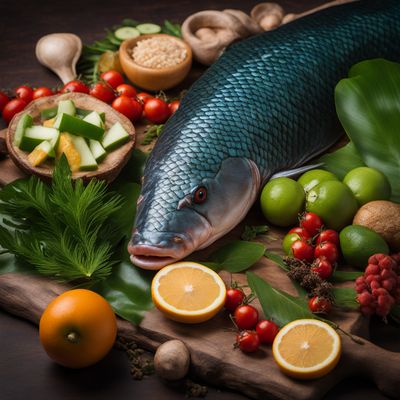
Ingredient
Nile perch
The Mighty Fish of the Nile: Unveiling the Secrets of Nile Perch
Nile perch, scientifically known as Lates niloticus, is a large freshwater fish native to the Nile River and other African lakes. It features a streamlined body with silvery scales and a slightly protruding lower jaw. With firm, white flesh and a mild, sweet flavor, Nile perch is highly sought after in the culinary world. Its meaty texture makes it suitable for various cooking methods, including grilling, baking, frying, and poaching. The fish can grow up to 6 feet in length and weigh over 200 pounds, making it an impressive catch for both fishermen and food enthusiasts.
Origins and history
Nile perch has a rich historical and cultural significance in Africa, particularly in countries like Egypt, Sudan, and Uganda. It has been a staple food source for local communities for centuries. In the 1950s, Nile perch was introduced to Lake Victoria, where it thrived and became an important commercial fish. However, its introduction also had ecological consequences, leading to the decline of native fish species in the lake.
Nutritional information
Nile perch is a nutritious fish, rich in high-quality protein, omega-3 fatty acids, and essential minerals such as potassium and selenium. A 3.5-ounce (100-gram) serving of Nile perch provides approximately 96 calories, 20 grams of protein, and 1.5 grams of fat.
Allergens
Nile perch is a fish and may cause allergic reactions in individuals with fish allergies.
How to select
When selecting Nile perch, look for fish with clear, bright eyes, shiny scales, and a fresh, mild aroma. The flesh should be firm to the touch and have a vibrant color. Avoid fish with dull eyes, discolored flesh, or a strong fishy smell.
Storage recommendations
To maintain the freshness and quality of Nile perch, it is best to store it in the refrigerator at a temperature of 32-39°F (0-4°C). Wrap the fish in moisture-proof paper or place it in an airtight container to prevent odor transfer. Consume within 1-2 days of purchase for optimal taste and texture.
How to produce
Nile perch is typically caught in the wild by professional fishermen. However, for amateur fish enthusiasts, it is not recommended to attempt to raise Nile perch as it requires specific conditions and large bodies of water.
Preparation tips
Nile perch can be prepared in various ways, such as grilling, baking, frying, or poaching. For grilling or baking, marinate the fish with herbs, lemon juice, and olive oil to enhance its flavor. When frying, coat the fish with a light batter or breadcrumbs for a crispy texture. Nile perch pairs well with citrus flavors, garlic, herbs like dill or parsley, and spices such as paprika or cumin. Be cautious not to overcook Nile perch, as it can become dry.
Substitutions
If Nile perch is not available, suitable substitutes include other white-fleshed fish like cod, haddock, or tilapia.
Culinary uses
Nile perch is commonly used in various cuisines, including African, Mediterranean, and Middle Eastern. It is often grilled and served with a side of vegetables or rice, used in fish stews, or incorporated into fish cakes or fish curries. The firm texture of Nile perch also makes it suitable for fish tacos or sandwiches.
Availability
Nile perch is commonly available in countries surrounding the Nile River, such as Egypt, Sudan, and Uganda. It is also exported to other parts of Africa, Europe, and the United States.
More ingredients from this category » Browse all

Asian swamp eel
The Aquatic Delicacy: Unveiling the Asian Swamp Eel

Silver perch
The Delicate Delight: Silver Perch

Mandarin fish
The Delicate Delight: Mandarin Fish

White crappie
The Delicate Delight: Exploring White Crappie

Gudgeons
Delicate Delights from the Water

Snakeheads(=Murrels)
The Mighty Murrels

Arapaima
The Mighty Arapaima: A Culinary Treasure from the Amazon

Catfishes (freshwater)
The Delicate Delight: Freshwater Catfish

Characins
The Diverse World of Characins: Exploring the Beauty and Variety of These Tropical Fish

Pike-perch
The Delicate Delight

Gourami (asia)
The Delicate Delight of Gourami

Largemouth black bass
The Prized Catch: Largemouth Black Bass


